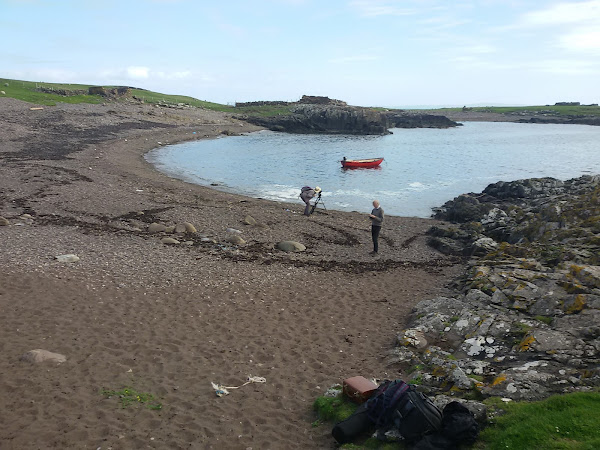While Jo and Rob filmed on the beach I took to the water with Tom Williamson again and
attempted to film hooks and line under water. Not only was it difficult to actually see what I
was filming with a GoPro on a stick underwater, I now realise how tricky it is to keep one's
hooks and lines in order..
And why the fishermen kept theirs carefully organised laid out in rows before setting them
out in the sea.
 |
| 19thC line and hooks laid out on a board |
I really would have made a rubbish fisherman.
However when I reviewed the footage later I realised that I'd managed to film the one that
However when I reviewed the footage later I realised that I'd managed to film the one that
got away - from Tom's hook...
So close... it then turns tail and swims off!
It is still an experience to see the land from the sea and to watch it appearing and
So close... it then turns tail and swims off!
It is still an experience to see the land from the sea and to watch it appearing and
disappearing as we head out
Back on shore Jo and Rob were still busy doing the far more serious business of recording
sounds and filming the sea.
From reading 19thC newspaper reports from Northmavine it is clear that fish
were not
In between filming and recording we have been collecting information about the lodges and shops that were used by the men during the fishing season. The
beautiful Day Book, which is part of the collection at
Tangwick Haa Museum, is a testament to the coming and goings from one of the
shop at Stenness during the fishing season.
Documenting the names of fishermen occupying the lodges we can find out what they were buying, and the price of rope, tea, hooks, counterpanes and sweeties and, on occasions, even cigars were purchased.
Documenting the names of fishermen occupying the lodges we can find out what they were buying, and the price of rope, tea, hooks, counterpanes and sweeties and, on occasions, even cigars were purchased.
 |
| Pages in the Day Book |
The book will be on display during our installation.
always plentiful during the season as articles in the local
newspapers in the 1890's indicate.
In addition to light loads, the fishermen are plagued by 'swarms of hoes' (which I think are
dog fish) which prevent them catching the white fish.
Then there are other problems..
 |
| 24 June 1876 |
What
the diet of the men consisted of and whether they were well nourished
or not, living
in such close proximity in pretty rudimentary conditions
meant that illnesses spread pretty
fast. It seems that, as usual, the
unsettled Shetland weather - thick fog and gales - also
put paid to
successful fishing trips.
At the end of the season in August 1877
Laurence Anderson is noted as having taken the
highest yield at 315cwt. But chief topic of conversation was the
ordinance survey that was
going on that year, with complaints of wheat
fields being trampled in the process of
mapping and threats of giving
the boys a dipping in the sea if they were seen in the corn
again.
 |
| Newspaper 18 August 1877 |
Another long day - home now for our own tea.












No comments:
Post a Comment